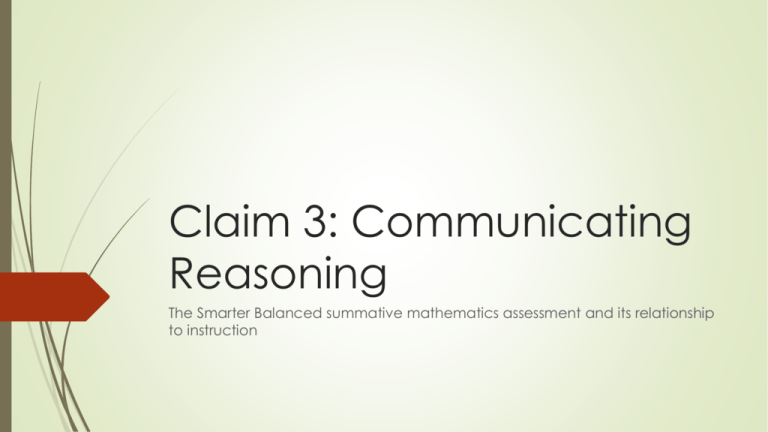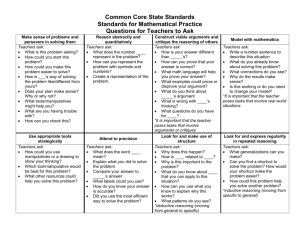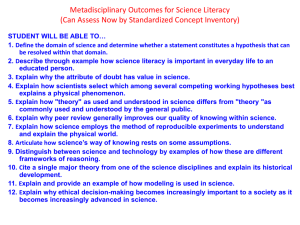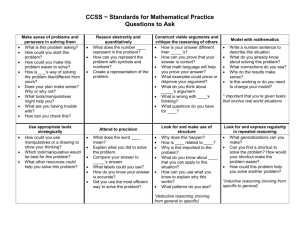Powerpoint
advertisement

Claim 3: Communicating Reasoning The Smarter Balanced summative mathematics assessment and its relationship to instruction What is Claim 3? Assesses students’ ability to clearly and precisely construct viable arguments to support their own reasoning and critique the reasoning of others. Somewhat similar to Washington’s short-answer items. Uses multiple item types in new assessment More Information More information about communicating reasoning for Claim 3 is available in the Mathematics Content Specifications, online at http://www.smarterbalanced.org/smarter-balancedassessments/ Claim 3 requires use of content in the Standards Communicating reasoning is critical for solid mathematical understanding. It provides a firmer foundation for future learning than just knowing a procedure. Claim 3 focuses on a particular standard or part of the standard. Examining a standard 4.NF.A.2 Compare two fractions with different numerators and different denominators, e.g., by creating common denominators or numerators, or by comparing to a benchmark fraction such as ½. Recognize that comparisons are valid only when the two fractions refer to the same whole. Record the results of comparisons with symbols >, =, or <, and justify the conclusions, e.g., by using a visual fraction model. Domains More information on Standards in Claim 3 The three Claim 3 documents, Grades 3 through 5, Grades 6 through 8, and High School are available online at http://www.smarterbalanced.org/smarterbalanced-assessments/#item Look under “Mathematics” in the Item/Task Specifications section. Claim 3 is based on the Mathematical Practices Mathematical Practices 3 and 6 are foundational support for Claim 3. 3. Construct viable arguments and critique the reasoning of others. 6. Attend to precision. Additional information on Claim 3 and the Mathematical Practices The Smarter Balanced Content Specifications, with additional information on how these practices inform Claim 3, is available online at http://www.smarterbalanced.org/smarter-balancedassessments/ Communicating Reasoning: A variety of skills Claim 3 has seven targets, with the last target reserved for later grades. The six targets are the same at each grade level. Each target describes a particular skill that should be developed in students as part of the ability to communicate and reason about mathematical ideas. Most items assess more than one target. Target A: Test propositions Test propositions or conjectures with specific examples. Tasks used to assess this target ask for specific examples to support or refute a proposition or conjecture. Grade 5 High School Target B: Justify or refute propositions or conjectures Construct, autonomously, chains of reasoning that will justify or refute propositions or conjectures. “Autonomous” in this target means students respond to a single question without further guidance. Target B has less scaffolding that Target A. Grade 5 Grade 8 Target C: State logical assumptions State logical assumptions being used. Students may be asked to identify the assumption, or they may be asked to use an assumption to answer a question. Grade 4 High School Target D: Breaking an argument into cases. Use the technique of breaking an argument into cases. Students look for conditions that make an argument true and those that show an argument is not true. Grade 7 High School Target E: Correct or flawed reasoning Distinguish correct logic or reasoning from that which is flawed, and if there is a flaw in the argument, explain what it is. Finding flaws in arguments helps students develop their own correct reasoning. Grade 3 Grade 8 Target F: Arguments based on concrete referents Base arguments on concrete referents such as objects, drawings, diagrams, and actions. Students may be asked to use a drawing or diagram to support or refute a conjecture. In later grades, concrete referents will often support generalizations as part of the justification of an argument. Grade 8 High School Target G: Determine conditions of an argument At later grades, determine conditions under which an argument does and does not apply. (For example, area increases with perimeter for squares, but not for all plane figures.) Often these tasks ask students to determine whether a proposition or conjecture always applies, sometimes applies, or never applies. Grade 7 Grade 7 High School More information on Claim 3 assessment More example items for each target are available in the Claim 3 item specifications, online at http://www.smarterbalanced.org/smarter-balancedassessments/#item Look under “Mathematics” in the Item/Task Specifications section. How Claim 3 informs assessment Students will reason about the central mathematical ideas in the standards. Students must go beyond recall and application of concepts and procedures. They will use evidence to support their thinking. Approximately one-fifth of the Smarter Balanced CAT and performance task assessments will consist of Claim 3 items. More information on Claim 3 assessment More information on Claim 3 on the summative assessment, both the computer-adaptive and the performance task portions, is available in the Test Blueprints, online at http://www.smarterbalanced.org/smarter-balancedassessments/ How Claim 3 informs instruction Students must be given opportunities to communicate reasoning. Claim 3 lends itself to a collaborative, open classroom. The classroom environment is richer than a summative assessment can be. Questions need to promote deep thinking. Further help Specific Claim 1, 2, and 4 videos are available on the website to get a more complete picture of each claim and the skills students should develop through focused instruction.







